Are Fiskars Axes Any Good? (explained with pics)
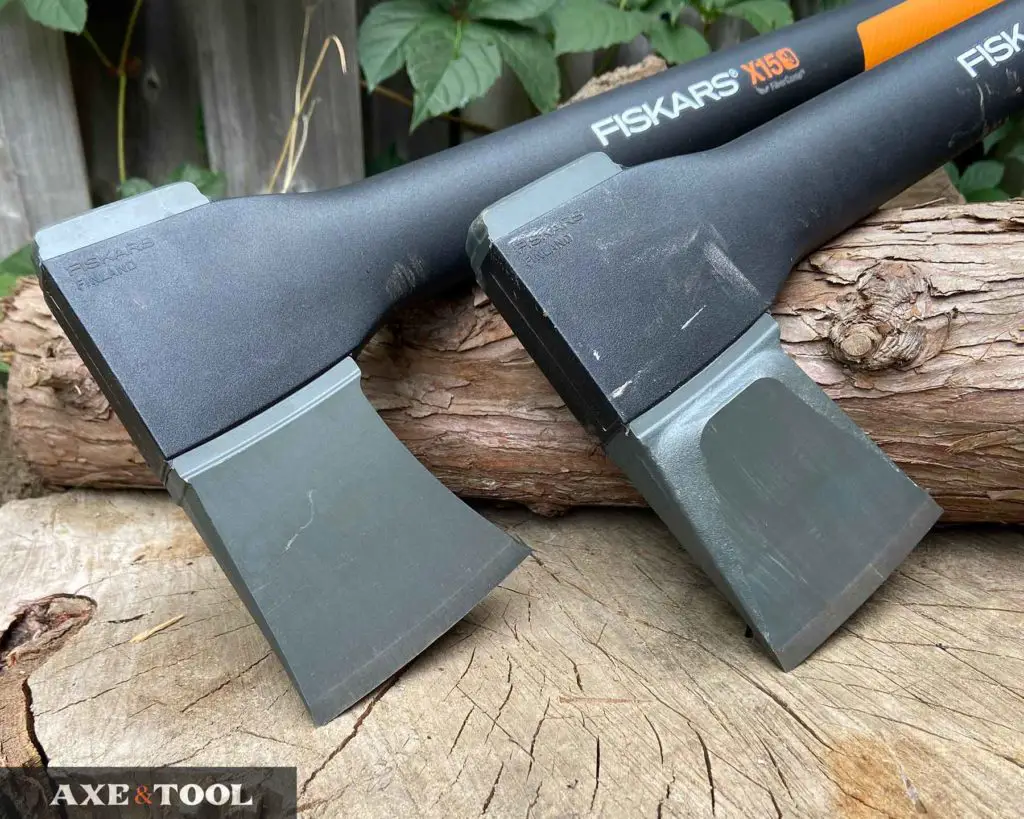
I bought my first Fiskars hatchet almost 10 years ago before I knew anything about axes. But it wasn’t until I started really using, collecting, and restoring axes, that I understood what I always liked about it.
Fiskars are good high-value axes. They come sharp, durable, and need little care. The splitting axes are one of the best cost/performance axes available. The chopping axes are good for all-around use. The edge will dull with use, but the nylon handle will never break or loosen.
I tend to recommend Fiskar axes a lot because they just work. Even though they don’t have the “best steel” or Instagram-worthy wooden handles – they offer a great combination of effectiveness, durability, low maintenance, and affordability. They’re designed to work and be easy to use, which is exactly what most of us are looking for.
Some people just don’t like the “plastic” look or feel compared to wood – and that is fair. Truthfully I love classic wood-handled axes. But I still own many Fiskars axes, and while they aren’t perfect, there is no denying that Fiskars axes get a lot of things right.
What Fiskars axes are (and aren’t) good for
The nice thing about Fiskars axes is there are over 15 different models to choose from, so they are good for a lot of tasks.
Fiskars makes great splitting axes
Fiskars splitting axes are the best cost/performance axes available. They are (almost) universally loved for how well they perform. The specialized head design has a sharp 30° edge, with flared cheeks that force the wood apart.
The nylon handle can also help pry wood apart, and withstand overstrikes in a way wood handles just can’t. There are 7 different splitting axes, so you should be able to find the perfect one for you (The only one I don’t have is the 20″ Norden N12).
I have an in-depth article here that can help you choose the right splitting axe for your needs.
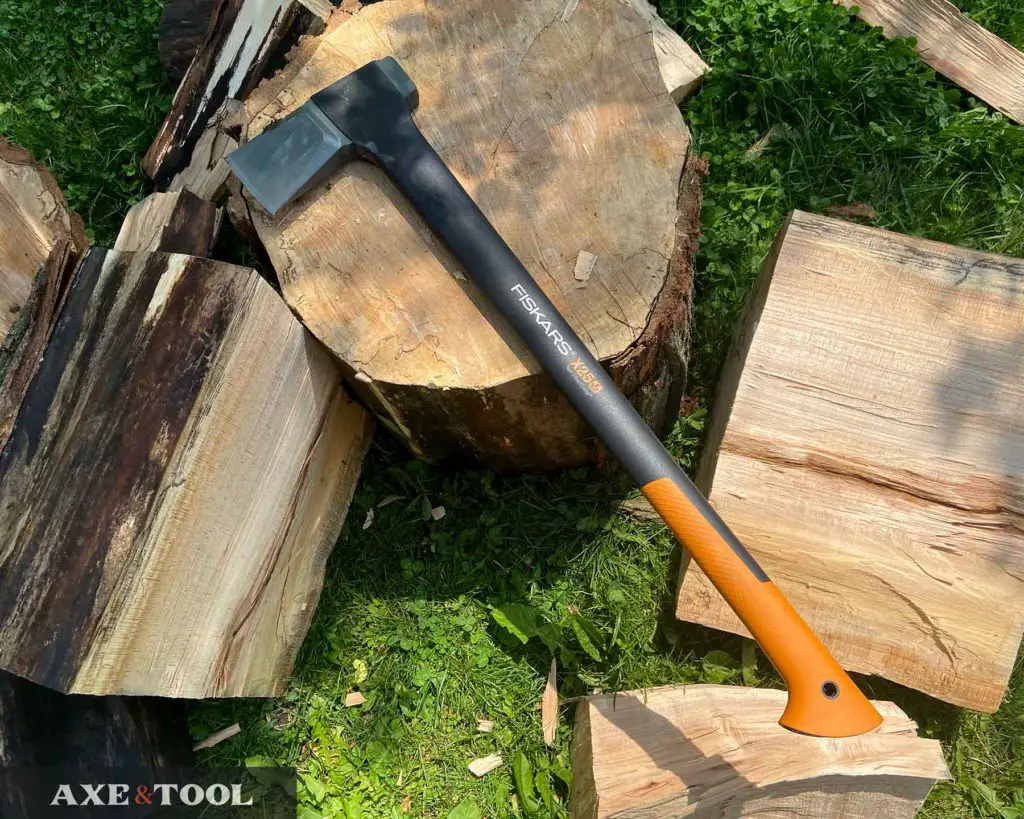
Even the standard wedge-shaped chopping axes split well for their size – the 12” chopping axe can also split 12” rounds if you are just looking for an “all-arounder” axe.
The larger splitters are capable of penetrating and splitting big rounds reliably. The most popular splitting axe is the 36” X27 but my go-to splitter is the X25.
Are Fiskars axes good for chopping?
The flat grind edge and wedge pattern of the chopping axes makes them decent chopper. It may not cut as deep as a thinner-bladed axe, but it will stick less and clear chips well – particularly in softwoods. The flat top of the head also makes them ideal for chopping logs on the ground (bucking) because there is less risk of the toe of the axe (top corner of the blade) digging into the dirt.
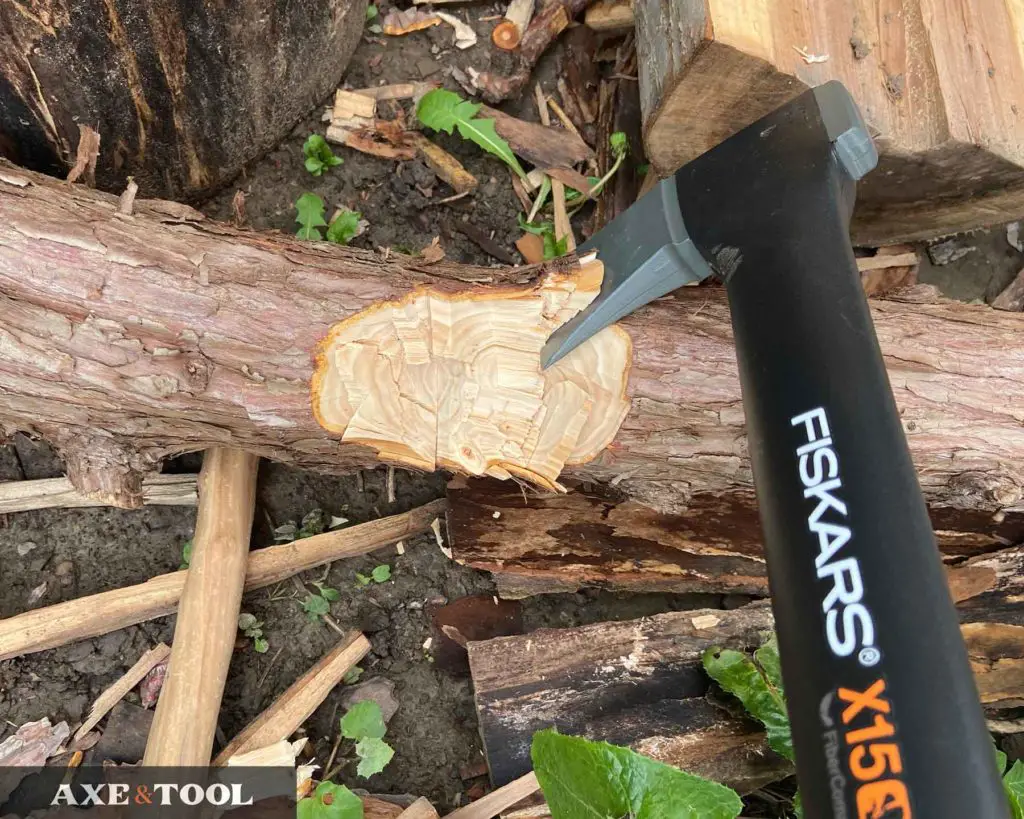
Not dedicated felling axes
The Fiskars chopping axes can cut down a tree just fine, but I wouldn’t use one as a dedicated felling axe. The axe is blade heavy on horizontal swings, so it can turn downward unless held tight. The handle is a little thick, round, and slick, meaning extra grip fatigue after long periods of (horizontal) use.
This isn’t an issue for a few trees here and there. But something like the Council Tool Boys axe or Jersey axe would be much better suited specifically for felling, at about the same price.
Fiskars axes for bushcraft?
Fiskars axes will work for most bushcraft tasks, but finer carving tasks may be more difficult. The 17” chopping axes will be best for bushcraft, as they can be used one or two-handed, and have a longer narrower head shape that is tailored to chopping tasks.
If you are in North America you will need to look for the Gerber 17.5″ Freescape or Fiskars Norden 7 – the standard X10 is hard to find. We have an article about Gerber vs Fiskars axes.
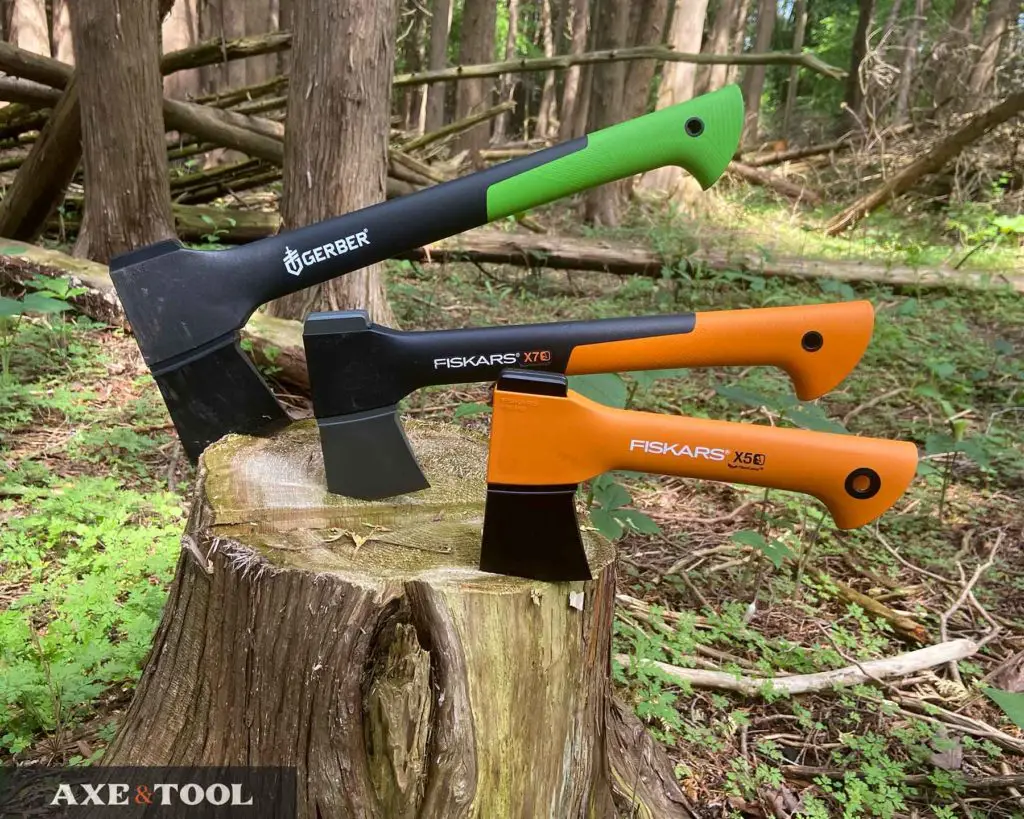
Fiskars are perfect for kindling
The sharp wedge-shaped head and durable nylon handles make Fiskars great axes for kindling. The wedge pops the grain apart quicker and easier than thinner blades. The X7 is the perfect size for kindling, but there are other chopping and splitting models (like the X11) to consider that can do heavier work too.
See our hands-on comparison of 5 Fiskars hatchets for kindling here.
Are Fiskars axes good for carving?
The Fiskars X5 or X7 could work as a beginner carving axe, but they are limited to rough carving. The flat grind blade is effective, but the wide wedge pattern and short bit are not ideal for fine carving, so your knife will do more of the work.
Fiskars as a throwing axe?
Fiskars axes are not suited for throwing. Despite being well-balanced and durable, the stout wedge shape of the head is unlikely to penetrate and stick in the wood.
What makes Fiskars axes good?
The number one reason I often recommend Fiskars axes is that you don’t have to do much maintenance.
To maintain your Fiskars axe just clean the blade with oil (like WD40) after use, and sharpen as needed. Wood-handled axes require extra care like oiling and proper storage, but the Fiskars composite handle makes these axes impervious to temperature and humidity changes.
The handle won’t warp or crack, and the head won’t come loose. The head also comes coated to prevent rust, but It will wear off with use pretty quickly at the edge, So a bit of oil will keep it rust-free, but I honestly don’t lose sleep if they do get a little rust.
Don’t go too crazy and just leave your axe outside year-round – but this is an axe you can use and leave in a shed, car, or wherever, and know it will be the same as how you left it. Even in climates with drastic seasonal weather.
I keep an X15 in the trunk year-round.
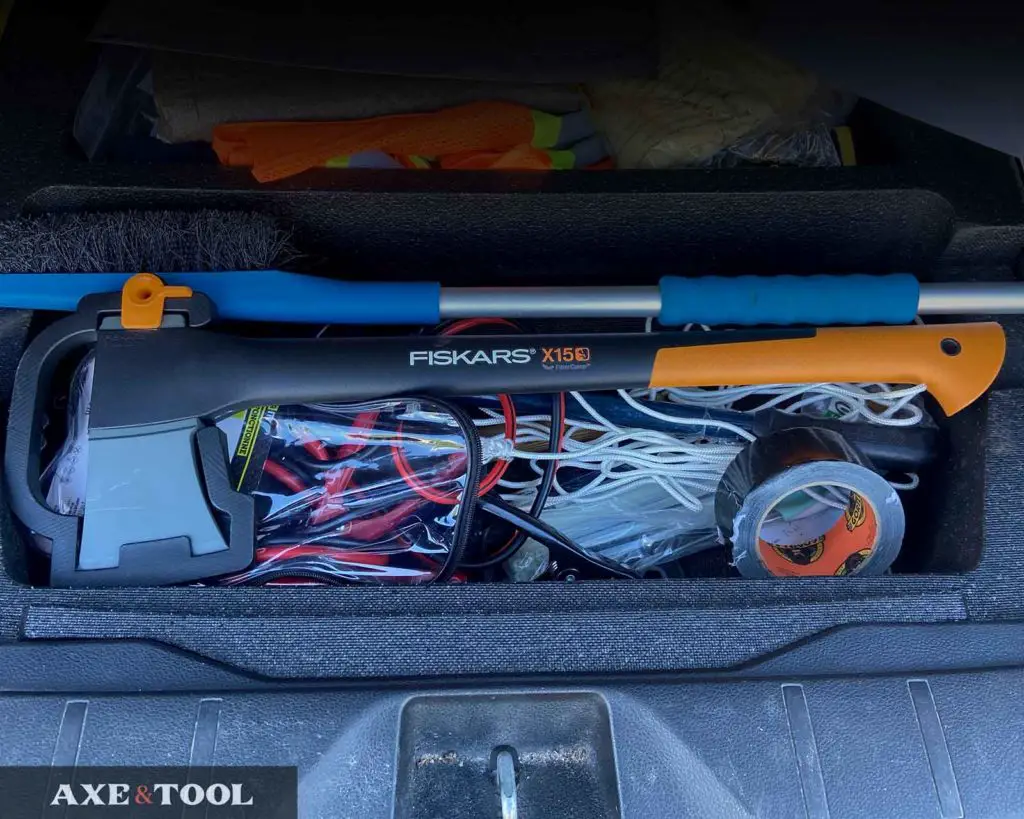
Extremely durable
Not only are Fiskars axes impervious to the weather, but they can also take a hit. Overstrikes are one of the most common ways people damage their axe handles, especially newer users. But the FiberComp handle won’t be damaged, broken or loosen with the impact.
What are Fiskars handles made of?
Fiskars Handles are made of a fiberglass-reinforced polymer called FiberComp. It’s light, strong, and offers good shock absorption.
You can smack and twist these axes to force them through a stubborn log without issue. I wouldn’t pound them with a sledgehammer – but I have used them as a hammer in a pinch.
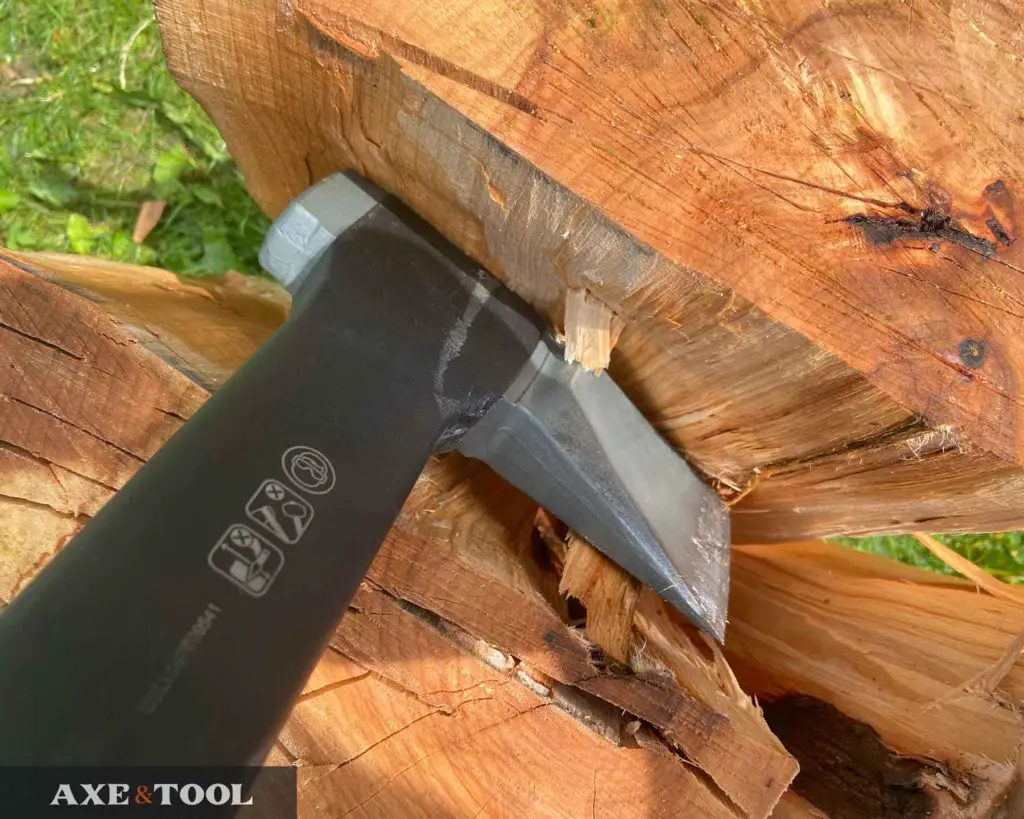
A Fiskars hasn’t failed me yet. I have seen pictures of broken handles, but it is incredibly rare.
Reduced vibration
The hollow FibreComp handle also does a really good job of absorbing and dampening vibration. This is critical for things like long periods of splitting, and one of the reasons the splitting axes are so good.
I would recommend the X-series models with the rubber over-mold grip for extended splitting. Having used both types of handles (with and without over-mold), the over-mold helps the hands more than I would have originally guessed.
The large flare at the bottom of the handle is great because you almost feel like you can let go on the downswing. It locks the axe into your hands.
Fiskars axes come sharp
The manufacturing process creates consistently sharp axes. Not shaving sharp, but good for a factory edge – especially for the price.
All Fiskars axes, chopping, and splitting come with a consistent and sharp 30° flat ground cutting edge from the factory. The flat grind creates a sharp cutting edge but it can roll or chip easier than a traditional convex grind.
Other axes in this price range (and even many more expensive axes) will come somewhat dull, or with a rough and inconsistent edge that’s been quickly hand-applied on a grinder. Workable, but often not pretty.
Sheath included

Value axes typically don’t include a sheath, especially one as well designed as the Fiskars. This is what allows them to sell the axes sharp. It keeps the edge covered, while being open and vented to prevent moisture build-up, and comes ready to be hung on a wall (or a pack) depending on the model.
Overall Value
You get everything listed above for between $35-$80. These axes blow away most of the competition at this price point. So keep that in mind when we get into the criticisms.
Criticisms
No axe is perfect, but I’ve found most of the really negative comments come from people who are comparing them to much more expensive axes (like Gransfors Bruks). The fact that people feel the need to defend their $150-200 axes against these $25-50 axes says a LOT.
Edge chips and rolls
Fiskars has a reputation for chipped and rolled edges. The flat grind is sharp but has a weaker tip than a common convex grind. Combine that with a bit softer (but still good) steel and you will get some chips and rolls on the edge.

It’s true, but I also think it’s often overblown. These little rolls and chips will not interfere with general use for a while. Sharpening is a part of the deal with any axe – even for the expensive ones.
The softer steel is easy to sharpen, and you can re-profile in a slightly wide point to reduce rolling in the future (just a tiny micro bevel 1/32 of an inch or so). It can be annoying but overall is not a big issue (remember the price point).
See our article on how to maintain your Fiskars axe so it can keep chopping for years here.
Less hardwood penetration
The wedge works pattern excels in softwood, but it won’t cut as deep in hardwood as thinner axes. The cutting edge also has barely any curve which doesn’t help. While a straighter bit is more durable, a curved bit will point load the force and dig deeper.
Again – I don’t really consider this a big issue. They work fine for most tasks, but it could slow you down if you are chopping/felling larger trees, cutting into a big notch.
Unforgiving feeling in hand
While the overall vibration control is good, there are some downsides to the plastic feel in hand.
It’s a less natural feeling (obviously) and less forgiving in the hands. You might notice some pain points with extended use. This is especially true of the black-handled models without the over-mold grip.
While the nylon handle is mechanically superior to wood, I find the slick rounded handles don’t have the same tactile control as a nice wood handle for maximum precision.
The hatchets have nice thin necks to make close work comfortable, but the 23″ and above axes get quite fat to support the larger heads. Some other 23″ axes could be used for detailed work, not Fiskars.
TIP: There’s always a little rough nub right under the blade that is right where you want to hold for fine work. This can be cut away simply with a knife.
Fiskars handles transfer the cold
At lower temperatures, the composite handles feel much colder than wood in hand and will hold the cold longer. It’s pretty noticeable side by side. Hot temperatures don’t seem to be an issue.
The orange over-molded section on the X-series is more comfortable in the cold so that would be a reason to not choose an all-black Fiskars axe.

Fiskars offers Confusing variations
There are a lot of confusing variations and models of Fiskars which can make choosing confusing. I have an article on how to choose a Fiskars axe, but here is a quick summary of the lines below.
X-series vs Black Fiskars
The orange over-mold handle of the X-series helps with grip, feel, and temperature. More than I was expecting. So I really would pick them first. But there is no difference in actual performance if you want to save a few bucks on the black models.

Norden Series
In 2019 Fiskars released a hybrid with the same injection molded head, attached to a wood handle. While the hickory handle would improve some of the comments on feel, I don’t think it’s worth it. The biggest drivers for me on Fiskars are the price and ease – and the price of the Norden axes make them far less appealing to me ($90ish). Time will tell how the wood handles hold up as well, but I would feel less comfortable leaving them in a hot car in the summer or freezing garage over winter.
Conclusion
Fiskars axes are a great high-value axe for people on a budget or who don’t want to worry about maintenance. It can be a great platform to learn how to use an axe and how to sharpen axes.
Please comment below If I missed something or if you have any questions. I do my best to respond to everyone.
About the author:
About the author:
Jim Bell | Site Creator
I’m just a guy who likes axes. I got tired of only finding crap websites, so I set out to build a better one myself.
I’m also on Instagram: @axeandtool


Thanks friend! Good article!
Why doesn’t Fiskar make a longer handled chopping axe. I need a long handled chopping axe. They are hard to find at least where I live. Most of the axes are splitting axes.
Thank You
Andrew Smith
I figure it’s because most people these days only need an axe for splitting firewood. Cutting is often done by chainsaw now. They make a black 28″ chopping axe – but thats as big as they go. Council Tool makes some great affordable chopping axes (if you are in the US) or Hultafors/Agdor internationally.
Great article! I have had lots of axes in my time and I haven’t had one better than my x27. I split 6 cords/year and my x27 is still going strong after close to 10 years.
Appreciate the comment! 10 years is a pretty strong endorsement – I’m about 4 years in with mine.